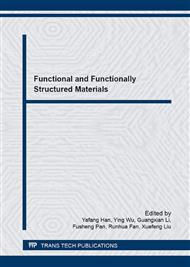[1]
J. Sun, J.F. Li, B.J. Zhang, et al, Development of Polyester Artificial Composite Granite and its Engineering Application, Manufacturing Technology & Machine Tool. 8 (2006) 85-87.
Google Scholar
[2]
W.H. Ji, Application of resin concrete casting in machine building, World Manufacturing Engineering & Market. 2 (2008) 100-102.
Google Scholar
[3]
W. Bai, J. Zhang, P. Yan, et al, Study on vibration alleviating properties of glass fiber reinforced polymer concrete through orthogonal tests, Materials & Design. 30 (2009) 1417-1421.
DOI: 10.1016/j.matdes.2008.06.028
Google Scholar
[4]
L. Wu, Study on high-speed milling machine's bed made of resin concrete, Modern Manufacturing Engineering. 2 (2004) 77-78.
Google Scholar
[5]
P. Li, Z. Ji, Y. Liu, Mineral Composite Material and Its Application on Machine Tools, Machine Tools & Hydraulics. 41 (2013) 159-163.
Google Scholar
[6]
S.G. Ai, L.Q. Tang, Y.Q. Mao, et al, Numerical analysis on failure behaviour of polyurethane polymer concrete at high strain rates in compression, Computational Materials Science. 69(2013) 389-395.
DOI: 10.1016/j.commatsci.2012.12.018
Google Scholar
[7]
A.Y. Yin, X.H. Yang, Z.J. Yang, 2D and 3D fracture modeling of asphalt mixture with randomly distributed aggregates and embedded cohesive cracks, Procedia IUTAM. 6(2013) 114-122.
DOI: 10.1016/j.piutam.2013.01.013
Google Scholar
[8]
W.Y. Ren, Z.J. Yang, R. Sharma, et al, Two-dimensional X-ray CT image based meso-scale fracture modelling of concrete, Engineering Fracture Mechanics. 133 (2015) 24-39.
DOI: 10.1016/j.engfracmech.2014.10.016
Google Scholar
[9]
G. Lilliu, J.G.M. Van Mier, 3D lattice type fracture model for concrete, Engng Fract Mech. 70 (2003) 927–41.
DOI: 10.1016/s0013-7944(02)00158-3
Google Scholar
[10]
C. Lopez, L. Carol, A. Aguado, Meso-structural study of concrete fracture using interface elements. I: numerical model and tensile behavior, Materials and Structures. 41(2008) 583–99.
DOI: 10.1617/s11527-007-9314-1
Google Scholar
[11]
Ł. Skarżyński, J. Tejchman, Calculations of fracture process zones on meso-scale in notched concrete beams subjected to three-point bending, European Journal of Mechanics / A Solids. 29 (2010) 746–60.
DOI: 10.1016/j.euromechsol.2010.02.008
Google Scholar
[12]
A. Yin, X. Yang, H. Gao, et al, Tensile fracture simulation of random heterogeneous asphalt mixture with cohesive crack model, Engineering Fracture Mechanics. 92 (2012) 40-55.
DOI: 10.1016/j.engfracmech.2012.05.016
Google Scholar
[13]
Q.L. Dai, Z.P. You, Prediction of creep stiffness of asphalt mixture with micromechanical finite-element and discrete-element models, Journal of Engineering Mechanics-ASCE. 133 (2007) 163-173.
DOI: 10.1061/(asce)0733-9399(2007)133:2(163)
Google Scholar
[14]
H. Kim, W.G. Buttla, Multi-scale fracture modeling of asphalt composite structures, Composites Science and Technology. 69 (2009) 2716-23.
DOI: 10.1016/j.compscitech.2009.08.014
Google Scholar
[15]
Z.Q. Yue, S. Chen, L.G. Tham. Finite element modeling of geomaterials using digital image processing, Computers and Geotechnics. 30 (2003) 375–97.
DOI: 10.1016/s0266-352x(03)00015-6
Google Scholar
[16]
N. Michailidis, F. Stergioudi, H. Omar, et al, An image-based reconstruction of the 3D geometry of an Al open-cell foam and FEM modeling of the material response, Mechanics of Materials. 42 (2010) 142–147.
DOI: 10.1016/j.mechmat.2009.10.006
Google Scholar
[17]
X.F. Xu, A multiscale stochastic finite element method on elliptic problems involving uncertainties, Computer Methods in Applied Mechanics and Engineering. 196 (2007) 2723-2736.
DOI: 10.1016/j.cma.2007.02.002
Google Scholar
[18]
X.F. Xu, X. Chen, Stochastic homogenization of random elastic multi-phase composites and size quantification of representative volume element, Mechanics of Materials. 41 (2009) 174–86.
DOI: 10.1016/j.mechmat.2008.09.002
Google Scholar
[19]
Z.J. Yang, X.T. Su, J.F. Chen, et al, Monte Carlo simulation of complex cohesive fracture in random heterogeneous quasi-brittle materials. International Journal of Solids and Structures. 46 (2009) 3222-3234.
DOI: 10.1016/j.ijsolstr.2009.04.013
Google Scholar
[20]
X.T. Su, Z.J. Yang, G.H. Liu, Monte Carlo simulation of complex cohesive fracture in random heterogeneous quasi-brittle materials: a 3D study, International Journal of Solids and Structures. 47 (2010) 2336–45.
DOI: 10.1016/j.ijsolstr.2010.04.031
Google Scholar
[21]
X.T. Qiao, H.Y. Zhao, Z.X. Zhao, et al, The preparation technology and its performance analysis of artificial granite material, Manufacturing Technology & Machine Tool. 10 (2011) 98-100.
Google Scholar
[22]
M. Zhou, H. Q. Liu, X. G. Wu, Aggregate Grading Research on Resin Concrete, Journal of Liaoning Technical University. 20 (2001) 770-772.
Google Scholar
[23]
Z.P. Shi, Design Method of SAC Asphalt Mixture, Communications Standardization. 23 (2010) 217-219.
Google Scholar
[24]
J.C. Walraven, Aggregate interlock: A theoretical and experimental analysis, Delft University of Technology, (1980).
Google Scholar
[25]
N. Tan, H.L. Li, Z.C. Li, The effect of strengthen-material on the performance of the polymer concrete, Concrete. 2 (2002) 31-35.
Google Scholar


